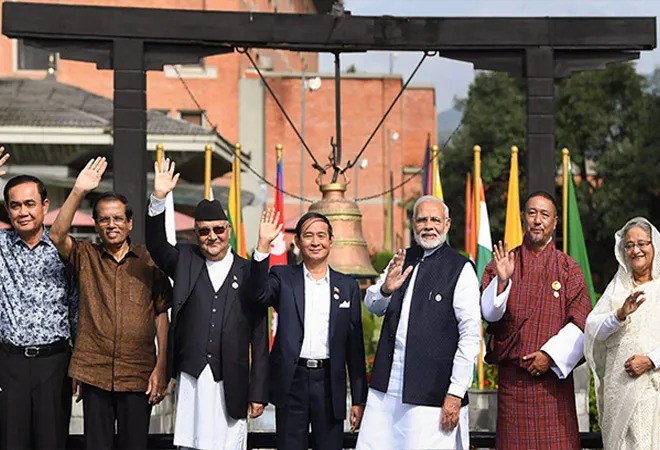
At the invitation of the Indian government, leaders of Bay of Bengal Initiative for Multi-Sectoral Technical and Economic Cooperation (BIMSTEC) member-states will attend the swearing-in ceremony of Prime Minister Narendra Modi’s second term on 30th May. There is a tendency to view the diplomatic move through the narrow prism of Delhi’s strategy to ‘isolate Pakistan’ and India’s supposed preference for BIMSTEC over South Asian Association for Regional Cooperation (SAARC).
To keep Pakistan out could have been a factor in Delhi’s calculus. However, to view the decision to invite the BIMISTEC leaders only through this lens overlooks Delhi’s wider regional strategic interests. For India, the strategic value of BIMSTEC is driven not by the Pakistan factor alone, rather the BIMSTEC as a neighbourhood forum presents its own strengths and weaknesses for India, independent of Pakistan and the SAARC.
For India, the strategic value of BIMSTEC is driven not by the Pakistan factor alone, rather the BIMSTEC as a neighbourhood forum presents its own strengths and weaknesses for India, independent of Pakistan and the SAARC.
Moreover, framing the diplomatic move by hyphenating SAARC and BIMSTEC to mean one’s gain is another’s loss does more harm to both the groupings. The single-factor view also fails to capture Delhi’s multi-dimensional regional interests and limits the scope of analysis in terms of assessing BIMSTEC on its own merit and how Delhi sees the grouping in advancing its interests in the Bay of Bengal subregion.
Re-imagining the Neighbourhood
As India’s interests move beyond its borders, the fixation with South Asia-centric notion of neighbourhood can no longer serve as a useful analytical framework in understanding and explaining India’s regional diplomacy.
Scholars have advanced concepts such as ‘immediate neighbourhood’ and ‘extended neighbourhood’ to explain Delhi’s emerging neighbourhood approach. Furthermore, the concept of ‘subregion’ has been employed to explore the emerging regional dynamics.
Scholars have advanced concepts such as ‘immediate neighbourhood’ and ‘extended neighbourhood’ to explain Delhi’s emerging neighbourhood approach.
Along with the BIMSTEC leaders, India has invited leaders representing two significant regions, namely Central Asia and Indian Ocean Region–––President of Kyrgyz Republic who is the current chair of Shanghai Cooperation Organisation (SCO) and Prime Minister of Mauritius, respectively. The re-imagining of neighbourhood allows Delhi to engage with different nations, subregions and regions.
Similarly, a neighbourhood community has been envisioned around the Bay of Bengal comprising key littorals (Bangladesh, India, Myanmar, Thailand and Sri Lanka) and two Himalayan nations (Bhutan and Nepal). India’s key strategic interests are interconnected with the nations in the subregion and BIMSTEC is a critical platform in securing its interests in the subregion and beyond.
Key Drivers
India’s engagement with the Bay of Bengal sub-regional forum are driven by both internal and external strategic imperatives. Internally, the development and security issues of India’s entire eastern seaboard, the Andaman and Nicobar Islands and the Northeast region are interlinked with nations in the Bay of Bengal subregion. Externally, three major policy initiatives guiding Delhi’s current regional approach involves the BIMSTEC subregion–––the ‘Neighbourhood First’ policy, the ‘Act East’ policy and the ‘Indo-Pacific’ construct. India’s current neighbourhood approach is informed by a greater appreciation of the logic of geography.
Externally, three major policy initiatives guiding Delhi’s current regional approach involves the BIMSTEC subregion–––the ‘Neighbourhood First’ policy, the ‘Act East’ policy and the ‘Indo-Pacific’ construct.
A domestic factor that drives India’s external engagement with its neighbours is in leveraging geography for domestic development. India’s frontier regions such as the Northeast region and the Andaman and Nicobar Islands are far off from the main economic centres of the country. The idea of transnational cooperation for the development of frontier regions has become an integral part of the government approach.
India shares both land and maritime boundaries with BIMSTEC members (land borders with Bangladesh, Bhutan, Myanmar, Nepal) and (maritime boundaries with Bangladesh, Myanmar, Sri Lanka and Thailand). The re-imagining of the Bay of Bengal subregion through the BIMSTEC forum has allowed a greater role for the Neighbourhood First policy. This also means that the sub-regional grouping holds an important place in the success of the policy.
The BIMSTEC subregion is where India’s ‘Act East’ policy begins. Maintaining close and cordial ties with the BIMSTEC nations ensures a smooth eastward drive for India. The subregion forms the first chain of nations serving as a launching pad for Delhi to engage with Southeast Asia and beyond.
The BIMSTEC subregion is where India’s ‘Act East’ policy begins. Maintaining close and cordial ties with the BIMSTEC nations ensures a smooth eastward drive for India.
Within the Indo-Pacific construct, the Bay of Bengal subregion finds itself at the centre of the emerging power play among major powers. Increasingly, the interests of major powers overlap and intersect in the Bay of Bengal subregion. This presents both challenges and opportunities for India. Geographical proximity to the Bay of Bengal subregion provides India a natural advantage, but it also means growing interests of major powers in the backyard.
China’s growing inroads into the Bay of Bengal subregion and the wider Indian Ocean region poses long-term strategic challenges for India. Under the Belt and Road Initiative (BRI), Beijing has proposed corridors such as the China-Myanmar Economic Corridor, China-Laos-Thailand Railway Cooperation and the China-Nepal Trans-Himalayan Multi-dimensional Connectivity in and around the Bay of Bengal.
China’s growing inroads into the Bay of Bengal subregion and the wider Indian Ocean region poses long-term strategic challenges for India.
Delhi’s approach has been to provide alternative options to the smaller neighbours and minimise their dependence on China’s infrastructure investment. However, questions have been raised on whether Delhi’s policy rhetoric is backed by developments on the ground as issues such as delivery-deficit often affect Indian infrastructure projects.
Inviting the BIMSTEC leaders is in line with Delhi’s emerging regional approach. This will hopefully inject new dynamism in the sub regional grouping and demonstrate Delhi’s greater commitment to the sub regional forum.
Going forward, it may be useful to assess each grouping on its own right. SAARC provides a platform for India to engage with the subcontinental neighbours and the relevance of this grouping need not wane just because of Delhi’s engagement with other forums. There is no reason not to believe that Delhi will not leverage SAARC as and when opportunity arises.
SAARC provides a platform for India to engage with the subcontinental neighbours and the relevance of this grouping need not wane just because of Delhi’s engagement with other forums.
Similarly, Delhi’s strategic interests in the Bay of Bengal sub region presents its own specific opportunities and challenges for Delhi to be leveraged to its advantage. This also applies to other India’s neighbourhoods such as the Middle East, Central Asia or the Indian Ocean region.
Comparing India’s engagements with groupings in different neighbourhoods is desirable and necessary. Nevertheless, framing the discussion in gains and losses serves neither the interests of the groupings nor that of India’s interests. There could be diverse and multiple pathways to building a community.
The views expressed above belong to the author(s). ORF research and analyses now available on Telegram! Click here to access our curated content — blogs, longforms and interviews.




 PREV
PREV


